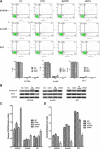Ets2 knockdown inhibits tumorigenesis in esophageal squamous cell carcinoma in vivo and in vitro
- PMID: 27556183
- PMCID: PMC5308664
- DOI: 10.18632/oncotarget.11369
Ets2 knockdown inhibits tumorigenesis in esophageal squamous cell carcinoma in vivo and in vitro
Abstract
Increased expression of Ets2 is reported upregulated in esophageal squamous cell carcinoma tissue. However, the function of Ets2 in carcinogenesis of ESCC is poorly understood. Here, the rise of Ets2 was confirmed in ESCC cells and Ets2 depletion by RNA interference promotes cell apoptosis, inhibits cell proliferation, attenuates cell invasion and induces cell cycle G0/G1 arrest in vitro. Moreover, in vivo, Xenograft mouse model studies showed Ets2 knockdown inhibits tumor formation and metastasis significantly. Furthermore, Ets2 depletion inactivates the mTOR/p70S6K signaling pathway both in vitro and in vivo. Taken together, these findings strongly suggest that a critical role of Ets2 in human ESCC pathogenesis via the inactivation of the mTOR/p70S6K signaling pathway.
Keywords: Ets2; apoptosis; esophageal squamous cell carcinoma; mTOR/p70S6K signaling pathway; proliferation.
Conflict of interest statement
These authors declare that there is no conflicts of interests concerning this paper.
Figures








References
-
- Seth A, Watson DK. ETS transcription factors and their emerging roles in human cancer. Eur J Cancer. 2005;41:2462–78. - PubMed
-
- Sharrocks AD. The ETS-domain transcription factor family. Nat Rev Mol Cell Biol. 2001;2:827–37. - PubMed
-
- Kasten M, Giordano A. Cdk10, a Cdc2-related kinase, associates with the Ets2 transcription factor and modulates its transactivation activity. Oncogene. 2001;20:1832–38. - PubMed
MeSH terms
Substances
LinkOut - more resources
Full Text Sources
Other Literature Sources
Medical
Miscellaneous

